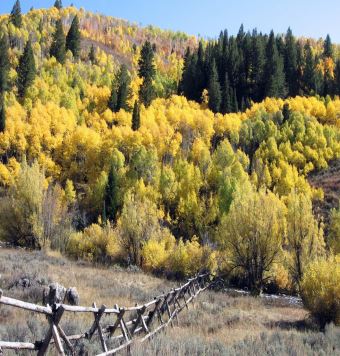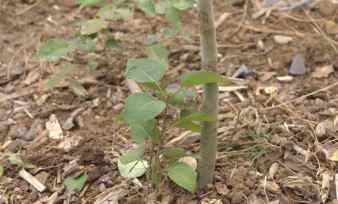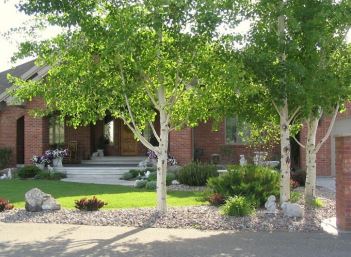033 - Aspen: How to Grow a Good Tree in a Bad Situation
Introduction

Aspen stand in Logan Canyon, Utah. Photo courtesy of Marion Murray.
Quaking aspen (Populus tremuloides) was made Utah’s state tree in March of 2014, replacing the Colorado blue spruce. Most of us have visited Utah’s mountains and have heard aspen leaves rustling in the breeze and seen their beautiful golden fall color. It is natural to want to have these trees in our home landscapes to re-create those outdoor experiences. However, aspen is a paradox – a beautiful mountain tree that makes a poor landscape tree.
Aspens can be useful ornamental plants in some situations. However, aspen in Utah is native to elevations above about 6,000 feet, while we commonly plant them at lower elevations where most of us live. They are not well adapted to the hotter, dryer conditions in those low elevation sites, and they also do not like the high pH, compacted soils found on those sites.
These harsh conditions are bad for aspens by themselves, but they also increase aspen’s susceptibility to insect and disease attack that can quickly harm or kill them.
Aspen Reproduction

New sucker sprouts coming from aspen roots.
Aspens reproduce and spread both by seeds and by producing sucker sprouts from roots, but the latter is the most common. New shoots constantly sprout from the roots, allowing the trees to reproduce quickly if they are damaged or otherwise stressed.
Aspen roots and suckers can spread a significant distance and after a few years the sprouts can form a thick stand of trunks interconnected by their roots. In fact, possibly the largest living organism on earth is a 100- acre clonal (genetically identical) stand of quaking aspens called “Pando”, near Fish Lake, Utah. While good for the survival of the tree after a disturbance in the wild, these sucker sprouts make aspen a troublesome choice for use in home landscapes. The shoots come up in the lawn and in flower or shrub beds. The roots and suckers cross property lines and become a problem for neighbors.
Aspens in Landscaping
Concrete curbing and other landscape edging materials will not stop aspen from spreading. The roots easily spread under or over these materials and can even grow under driveways and sidewalks. Durable metal or plastic barriers that penetrate at least 2 feet into the ground are more likely to contain aspen, though the roots can grow over the top of them. Even with these potential problems many people still want aspens in their landscapes.
Aspen is very available at nurseries and garden centers. Plant aspen the same as you would other trees and shrubs. See our fact sheet Planting Landscape Trees.
Urban Aspen Management
A naturalistic management strategy can prevent many of the common problems of growing aspens, though the spreading roots and sucker sprouts will still occur. The idea is to let the sprouts come up and then thin (remove) most of them so they are spaced every few feet. This will keep the “stand” from getting too dense. Then as the trunks grow, cut most of them out when they are around 6 inches in diameter. This gets rid of the trunks that are starting to be damaged from borers (boring insects), and from stem cankers and other diseases that occur more as the trees age. This strategy creates an aspen “stand” you can manage indefinitely, that will be less affected by insects and diseases. However, you will still have to deal with sprouting if you grow aspens.
Aspen Cultural Requirements
- Location - Plant where they are protected from high winds to reduce breakage.
- Exposure - Prefer full sun – more than 6 hours per day.
- Soil - Tolerates a wide range of soil conditions as long as adequate drainage is provided. Susceptible to iron chlorosis at high soil pH, with compacted soil, or when over watered. See the USU fact sheet “Control of Iron Chlorosis in Ornamental and Crop Plants"
- Water - Keep soil moist during establishment but allow it to dry out some between irrigations. Moderately drought tolerant once established, but requires deep watering every other week (several inches at a time) during the summer. Use a probe (like a screwdriver) to check that water is reaching at least a foot deep. A probe will penetrate moist soil but not dry soil.
- Fertilization - Not generally needed.
- Insects and Diseases - Prone to many pests and diseases including leaf spots, borers, leaf miners, tent caterpillars, internal stem decay. See the USU Extension Utah Pests fact sheet “Important Pests of Ornamental Aspens” for more information on aspen pests.
- Concerns - Weak-wooded, may sucker profusely, many pests and diseases, short-lived.
Published March 2018.


